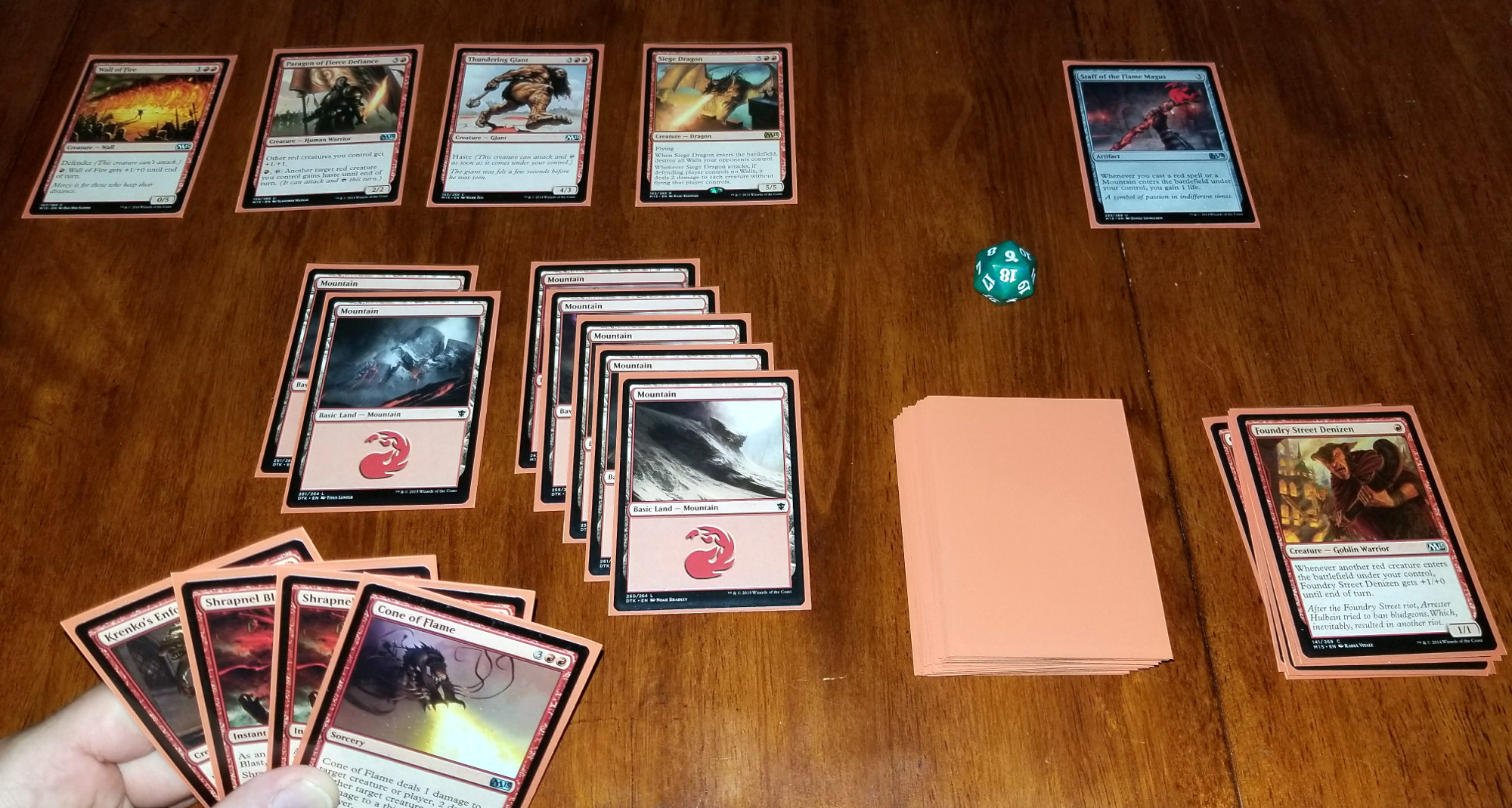How a System’s Protocols Are Communicated Through Direct Expression and Surrounding Texts
RQ2: How are the protocols of a system communicated distinctly (1) through their direct enactment/expression and (2) via the texts describing/surrounding that system?
There were several material components of Magic play that reflected its protocological rhetoric in that they signalled to us, as players, about how to understand the game, and make use of its mechanics to win the game, in specific ways. In particular, the layout of the battlefield (how all the cards are physically arranged on the table for a given game—see the example photo below) communicates to each player information about what sorts of cards are in play and how many cards are in a player’s hand (or library, graveyard, or exile area). Further, battlefield layout communicates how those cards are all functioning at any given moment—in particular, the notion of the tapped card, where a card is positioned at a 90° angle (landscape orientation) from its normal (portrait orientation) position to indicate its inability to be used for certain actions, helps each player get a reasonably quick grasp of the amount and variety of resources available to themselves and their opponent.

The photo above shows a typical battlefield arrangement near the start of a player’s turn. Near the top left corner of the photo, several creature cards are lined up beside one another. Below the creatures are several land cards, arranged closely together to take up less space. A third row (of a single card) near the top right of the photo serves to distinguish an artifact card from cards in the other areas. The player’s hand of four cards, a mix of creatures, sorceries, and instant spells, is visible at the bottom of the picture. A 20-sided die serves as a life counter (currently set at nine). A face-down pile of cards serves as the player’s library, from which cards are drawn. Face-up on the other side of the library is the player’s graveyard, where cards are placed after leaving the battlefield.
At times, the presentation of one or both players’ battlefield information was upset by individual need to access data in particular ways—such as picking up a card to read its abilities more closely. While these moments were rare, they did nonetheless inform how each player would, or could, pace themselves in a given game; an opponent’s need to scrutinize something might allow a player to reexamine the battlefield at large or to consider alternative strategies with the hand they currently possessed. At times, particular areas of the battlefield that had gained focus during one phase of play might lead to inadvertently forgetting other areas that might end up being equally, or more, important.
Similarly, an especially significant concept for Magic gameplay is the stack, a very particular workflow for the expression of cards whose abilities and effects are in the process of resolving. As one card is cast, another might be cast to complement—or cancel—it, and yet another might be added in for another effect, and so on. Each of these cards is added to a conceptual stack, or pile, of cards, with each consecutive card played being layered atop those preceding it. Once all cards for a given action are played, they resolve in reverse order, with the most recent card resolving before the one below it, which is then resolved before the one below it, all the way back to the first card. Each player is forced to anticipate potential complications to each card they play, since responses to one or more cards might utterly negate the initial desired outcome from the first card being played.
In our games, there was no desire to mislead or confuse opponents through exploitation of physical battlefield/tabletop space or overly complicated card combinations or stacks (although this last issue was due mostly to the limited variety of cards we had access to in order to create game-winning combinations). While providing inaccurate information is considered bad form in any Magic-related circumstance, obfuscating information by way of leaving unstated any potentially important information that is not expressly requested by an opponent (such as how one card might have an effect on multiple other cards on the battlefield) is considered a shrewd strategy by some competitive players. In other games, we can see similar tactics, such as not pointing out an opening to an opponent in chess or attempting to maintain a poker face in a game of Texas Hold'em. One of the most common memes for Magic is the abbreviation RTFC ("read the fucking card"), a sentiment that assumes players will take the time to read card details and that card details explain their capabilities in a clear enough manner to require no further interpretation. In casual circles, this can lead to disagreements when players reach different conclusions about card abilities; in competitive circles, the Magic: The Gathering Comprehensive Rules are examined—whether directly or indirectly, through trained game judges who serve as referees, as an impartial arbiter of disputes.